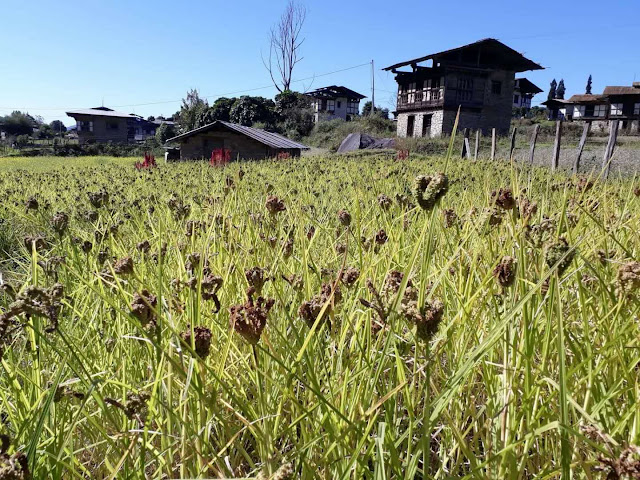 |
| Farmers with Agriculture Extension Officers displaying their rich germplasm |
Background
The four Gewogs (block)
viz; Phangkhar, Goshing, Trong and Bardo Germplasm Collection Expedition (GCE)
was conducted in 2016 as part of 11th Five Year Plan (FYP) of
2016-2017 fiscal years based on our work plan. This time collection was based on 2018 to 2019 fiscal year work
plan of 12th FYP making completed mission for Zhemgang Dzongkhag.
The next phase could be replacing non-viable seeds of same samples with
locations and refills and rebuild those accessions of poor germination and low viability
performance in the genebank.
Objectives
·
To explore and collect germplasm from
remaining four Gewogs
·
To study and capture diversity with
farming system across these Gewogs
·
To formulate and recommend future policy
and technical related backstopping programme
Methodology
The
collection team didn’t collect from next households if one provides all
diversity within one location. Captured and maintained uniqueness with quality
seeds sample across Chiwogs (sub-block). The Agro-biodiversity and germplasm
collection expeditons objectives were shared based on their time availability
and seeds payments were made as the
prevailing rates in their locality.
 |
| Maize shelling for collection |
Findings
The
Drunaghu (Nine Traditional Crops of Bhutan) diversity existence and current
cultivation practices were on verge of extinction due to following reasons:
·
Availability of hybreed seeds
·
Poor yield and production of traditional
crops
·
Land fragmentation
·
Shifting cultivation ban
·
Changes in the source of income
generation
·
Lack of awareness on market and value
addition
·
Human wildlife conflict
·
Labour shortage
·
Poor knowledge on nutrition diversity
consumption and its diets
·
Limited contemporary agriculture
practices and income generating ideas
·
Lack of consistent hard work and
permanent ingrained mindset of subsistence farming.
To interpret further on
this, especially the farmers of Bjoka, they focused mainly on bamboo products
weaving and its arts. Farmer’s cultivate only few numbers of crops and maintain
mini-vegetables garden. In some Chiwogs, they land up buying vegetables from
other chiwogs despite repeated awareness and training given by Gewogs
Agriculture Extension officers. So, their main plant, yula and cane products
sustainability issues pose threat to their livelihood in future if not
harvested with careful sustainable management practices.
The traditional crop
species richness and diversity in this Gewogs remained gloomy due to
aforementioned reasons and therefore, likelihood of knowing and seeing these
crops by our future generation are less optimistic.
 |
| Bamboo products weaving |
Conclusion
The germplasm
exploration and collection of four remaining Gewogs under Zhemgang Dzongkhag
was successful completed and all in all covered all eight Gewogs since
collection from 2016 January. All stakeholders; local government especially
farmers were very positive about our programme and work. Hence we are looking
forward to full seeds processing and conservation into our gene bank with all
necessary data and information as per the standard protocols.
Pictorial
information’s to Germplasm expedition 2019.
 |
| Amaranthus caudatus. Source: Mrs.Cheki Wangmo and Mr. Ugyen Phuntsho |
 |
| Barley in Shingkhar Gewog. Photo courtesy: Mrs. Cheki Wangmo and Mr. Ugyen Phungsho |
 |
| Finger Millet in Shingkhar, Zhemgang, Finger millet. Photo courtesy: Mrs. Cheki Wangmo ans Mr. Ugyen Phuntsho |
 |
| Buli Zhemgang. |
Submitted by: Ms.Cheki Wangmo-Sr. Biodiversity Supervisor II, Mr. Ugyen Phuntsho-Senior Biodiversity Supervisor I, and Mr.Wang Tshering-Biodiversity Supervisor and Mr. Tandin Wangchuk-ESP
………………………………………………………………………………………………………








No comments:
Post a Comment